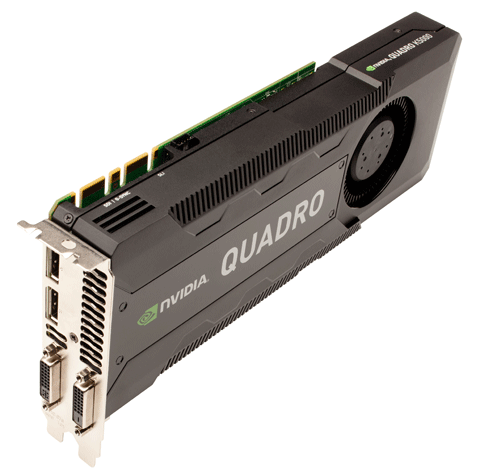
The new Nvidia Quadro K5000 features 4GB of ECC memory and four display outputs (2 x DisplayPort + 2 x DVI).
SIGGRAPH 2012 marked a change in messaging from Nvidia’s workstation folk. Instead of giving the stage to its new professional Kepler-based graphics card, the Quadro K5000, the spotlight was on the second generation of Nvidia Maximus.
Maximus is all about putting ‘cluster server level of performance back into the technical workstation,’ says Nvidia’s David Watters. And to do this you need a combination of Quadro GPUs for graphics and Tesla GPUs for compute.
With each GPU having its own defined role, the idea is users of CAD/CAM/CAE software can ‘design and simulate’ or ‘design and render’ at the same time with ‘no performance hit.’
Of course it all comes down to applications and Nvidia’s big investment in CUDA, its parallel computing architecture, looks to be paying dividends for the time being. Nvidia’s CUDA team has helped a number of simulation and rendering software developers embrace GPU compute in their applications – the benefit to Nvidia being that the software will only work effectively with Nvidia GPUs.
Nvidia is also publically backing OpenCL, the open computing language for writing programs that execute on CPUs and GPUs on multiple platforms, including those from Intel and AMD, but there’s no hiding the fact that Nvidia would love CUDA to become the industry-standard. In terms of numbers, OpenCL-powered applications currently lag behind their CUDA counterparts.
Apart from some core driver optimisations, second gen Maximus is not a whole lot different to the original Fermi-based Maximus. In Windows the driver essentially ensures the right GPU is assigned to the right task (graphics or compute).
The real difference comes from the new generation Kepler GPU architecture, which should give CAD/CAE software developers more GPU compute programming tools at their disposal for future GPU-powered applications.
Nvidia has introduced two new Kepler-based GPUs – the Quadro K5000, a replacement for the Quadro 5000 graphics card, and the Tesla K20 compute board.
The Quadro K5000 features 4GB of ECC memory and four display outputs (2 x DisplayPort + 2 x DVI) and will ship in October 2012. The Tesla K20 will be available in December 2012, though Nvidia didn’t share any specifications.
There was no official word on any other Quadro graphics boards, but Nvidia is likely to extend Kepler up and down the product line later this year.
As a technology, Nvidia’s Kepler has some interesting new features.
For GPU compute, ‘dynamic parallelism’ is designed reduce the amount of data moving between CPU and GPU to help boost overall performance. The technology enables the GPU to dynamically ‘spawn’ new threads without having to go back to the CPU.
Nvidia used the example of a CFD simulation where, as a problem progresses, more computation is required in certain areas. With dynamic parallelism, big chunks of data are transferred to the GPU and then the GPU decides where more precision is needed and subdivides accordingly.
Hyper-Q is another computation-focused feature of Kepler that enables multiple CPU cores to simultaneously utilise the cores on a single GPU. According to Nvidia this is ideal for applications that use MPI (Message Passing Interface), a code used by cluster aware CAE software that is designed to work with multiple machines in a distributed environment.
Both features are currently specific to Nvidia CUDA and would need to be implemented by the simulation (CAE) software developers moving forward.
For graphics, Kepler introduces two new anti aliasing modes – FXAA/TXAA – that are designed to offer high levels of quality at the same performance that you would get with low-levels of anti-aliasing. This should be of particular interest to those using powerwalls for automotive styling, where displaying the edges of a design smoothly is of paramount importance.
Power efficiency is also a big focus for Kepler. Nvidia claims its new 192 core SMX multiprocessor design is three times more energy efficient than its predecessor, Fermi’s 32 core SM design. Nvidia says this leads to more performance at the exact same or lower power requirements.
When Kepler ships later this year, second gen Maximus workstations will be available from all the usual suspects – Dell (Precision T3600, T5600, T7600 and R5500), HP (Z420, Z620 & Z820), Lenovo (ThinkStation S30, D30 & S30) and Fujitsu (Celsius M720 & R920).
BOXX and SuperMicro are also official launch partners and DEVELOP3D expects to see second gen Maximus machines from workstation manufacturers in the UK, including Scan and Workstation Specialists.
We are currently testing out Fermi-based Nvidia Maximus with a range of CAD and design viz applications. We’ll be posting our findings on DEVELOP3D.com shortly.
Meanwhile, AMD has also launched a new range of professional graphics cards – the FirePro W Series. You can read our report here.






